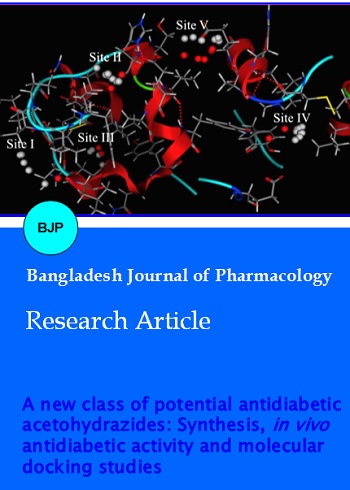A new class of potential antidiabetic acetohydrazides: Synthesis, in vivo antidiabetic activity and molecular docking studies
DOI:
https://doi.org/10.3329/bjp.v12i3.31428Keywords:
Tetrazolopyridine-acetohydrazide, diabetes mellitus, antidiabetic agent, plasma glucose, glibenclamide.Abstract
Two new pharmacologically active series of tetrazolopyridine-acetohydrazide conjugates [9 (a-n), 10 (a-n)] were synthesized by reacting a variety of suitably substituted benzaldehydes and isomeric 2-(5-(pyridin-3/4-yl)-2H-tetrazol-2-yl)acetohydrazides (7, 8). The synthesized compounds were analyzed through FTIR, 1H NMR, 13C NMR and elemental techniques. These acetohydrazides were screened for their in vivo antidiabetic activity and molecular docking studies. An excellent agreement was obtained as the best docked poses show-ed important binding features mostly based on interactions due to an oxygen atom and aromatic moieties of the series. The compounds 9a, 9c and 10l were found to be the most active in lowering blood glucose, having the potential of being good antidiabetic agents.
Video Clip of Methodology:
Synthesis of 3/4-(2H-tetrazole-5-yl)pyridine: 1 min 57 sec Full Screen Alternate
Downloads
160
122 Read
13

Published
How to Cite
Issue
Section
License
Authors who publish with this journal agree to the following terms:
- Authors retain copyright and grant the journal right of first publication with the work simultaneously licensed under a Creative Commons Attribution License that allows others to share the work with an acknowledgement of the work's authorship and initial publication in this journal.
- Authors are able to enter into separate, additional contractual arrangements for the non-exclusive distribution of the journal's published version of the work (e.g., post it to an institutional repository or publish it in a book), with an acknowledgement of its initial publication in this journal.
- Authors are permitted and encouraged to post their work online (e.g., in institutional repositories or on their website) prior to and during the submission process, as it can lead to productive exchanges, as well as earlier and greater citation of published work (See The Effect of Open Access).
